PEMODELAN FREKUENSI DAN SIMULASI GETARAN SENAR GITAR BASS LISTRIK DAN GITAR AKUSTIK [FREQUENCY MODELING AND VIBRATION SIMULATION OF ELECTRIC BASS AND ACOUSTIC GUITAR STRINGS]
DOI:
https://doi.org/10.19166/jstfast.v7i2.7594Keywords:
acoustic guitar, electric bass guitar, frequency simulation, partial differential equationAbstract
Mathematical equations can represent numerous real-world scenarios, a process known as mathematical modelling. Within this paper, we undertake modelling two musical instruments, specifically the electric bass guitar and the acoustic guitar. Our approach uses partial differential equations (PDEs) to represent these instruments accurately. By establishing the initial condition, we derive the final solution and simulate the frequency using parameters obtained from this solution alongside a frequency formula. The PDE for the electric bass guitar is of non-homogeneous second order, while the PDE for the acoustic guitar is of homogeneous fourth order. The simulation outcomes demonstrate that a lower vibration frequency for the electric bass guitar corresponds to a decreased string density, given a fixed tension. Similarly, this correlation holds for the acoustic guitar. With fixed string tension and Young's Modulus, a lower string density leads to a higher frequency and reduced inertia. Additionally, we provide graphical representations of the analytical solutions for both PDEs.
Bahasa Indonesia Abstract:
Persamaan matematika dapat memodelkan banyak situasi dalam dunia nyata. Proses ini disebut pemodelan matematika. Salah satu contoh yang dapat dimodelkan adalah frekuensi alat musik (gitar bass listrik dan gitar akustik). Kedua alat musik tersebut dimodelkan frekuensinya dengan persamaan diferensial parsial (PDP). Solusi akhir akan diperoleh berdasarkan kondisi awal. Simulasi frekuensi dilakukan berdasarkan parameter yang ditemukan dari solusi akhir dan rumus frekuensi. PDP untuk gitar bass listrik adalah orde dua non-homogen, dan PDP untuk gitar akustik adalah orde empat homogen. Hasil simulasi menunjukkan bahwa untuk gitar bass dengan tegangan tertentu, senar dengan densitas rendah menghasilkan frekuensi getaran yang lebih rendah. Hasil yang konsisten juga ditunjukkan untuk gitar akustik. Pada tegangan senar dan Modulus Young yang diberikan, senar dengan densitas rendah menghasilkan frekuensi yang lebih tinggi dan inersia yang lebih rendah. Beberapa grafik solusi analitik dari kedua PDP tersebut juga ditampilkan dalam artikel ini.
References
Anton, H., & Rorres, C. (2005). Elementary linear algebra (9th ed.). John Wiley & Sons, Inc.
Arfken, G. B., Weber, H. J., & Harris, F. E. (2013). Mathematical methods for physicists (7th ed.). Elsevier, Inc.
Brown, J. W., & Churchill, R. V. (2009). Complex variables and applications (8th ed.). McGraw-Hill Companies.
Harmonic Motion. (N.d.) Retrieved July 12, 2022 from https://labs.phys.utk.edu/mbreinig/phys221core/modules/m11/harmonic_motion.html
Kobayashi, T., Wakatsuki, N., & Mizutani, K. (2010). Inharmonicity of guitar string vibration influenced by body resonance and fingering position. Proceedings of the International Symposium on Music Acoustics (1321). Associated Meeting of the International Congress on Acoustics.
Kusumastuti, A., Jamhuri, M., & Hidayati, N. A. (2019). Analytical solution of the string vibration model on Sasando musical instrument. Journal of Physics: Conference Series, 1321, 022088. http://doi.org//10.1088/1742-6596/1321/2/022088
Lambson, O. C. (2018). The effects of a magnetic pickup on the vibration response of an electric guitar string [Thesis]. Stellenbosch University, Afrika.
Strauss, W. A. (2008). Partial differential equations: An introduction (2nd ed.). John Wiley & Sons, Ltd.
Vinod Kumar, A. S., & Ganguli, R. (2011). Violin string shape functions for finite element analysis of rotating Timoshenko beams. Finite Elements in Analysis and Design, 47(9):1091-1103. https://doi.org/10.1016/j.finel.2011.04.002
Wijnand, M., d’Andréa-Novel, B., Helie, T., & Roze D. (2020). Active control of the axisymmetric vibration modes of a tom-tom drum using a modal-based observer-regulator. Forum Acusticum (pp. 639-646). HAL Open Science. http://doi.org/10.48465/fa.2020.0439
Downloads
Published
Issue
Section
License
“Authors who publish with this journal agree to the following terms:
1) Authors retain copyright and grant the journal right of first publication with the work simultaneously licensed under a Creative Commons Attribution License (CC-BY-SA 4.0) that allows others to share the work with an acknowledgement of the work's authorship and initial publication in this journal.
2) Authors are able to enter into separate, additional contractual arrangements for the non-exclusive distribution of the journal's published version of the work (e.g., post it to an institutional repository or publish it in a book), with an acknowledgement of its initial publication in this journal.
3) Authors are permitted and encouraged to post their work online (e.g., in institutional repositories or on their website). The final published PDF should be used and bibliographic details that credit the publication in this journal should be included.”



